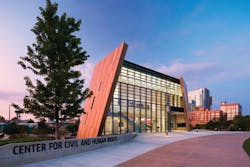At the Frontline: Securing the heritage of the civil rights movement
Located in the heart of downtown Atlanta, the Center for Civil and Human Rights serves as a memorial to the American civil rights movement of the 1950s and 1960s, as well as the modern day human rights movement. The 42,000-square-foot museum, which opened in June, features four primary exhibits including a rare collection of personal papers and items belonging to Dr. Martin Luther King Jr. To secure these and other irreplaceable artifacts housed within the facility, the center relies on a combination of in-house staff and third-party security personnel.
Mary Parker, president and CEO of All(n)1 Security, said that her company provided security during the construction of the World of Coca-Cola, which is located within the Pemberton Place complex along with the center and the Georgia Aquarium, which is how they initially became involved with the center. When construction of the museum was first announced, Parker said she knew it was a project she “absolutely wanted” her company to be involved with.
“Being an African-American owned company, it is an absolute honor for us to secure such a site as the museum which contains so much data on the journey of African Americas,” said Parker. “Furthermore, this is probably one of the most personal accounts to me that we have. I marched with Dr. King in the 60s and I have the pleasure of considering his daughter to be one of my friends.”
Sonya Pierce, director of facilities for the Center for Civil and Human Rights, is in charge of managing the entire museum – everything from the maintenance and cleaning staff to engineers and security personnel. Pierce said she relies on Parker and her team to keep visitors and staff at the center safe.
“Given the nature of our museum, we’re very sensitive to what’s going on in world events,” said Pierce. “We have to be very careful in our screening process to make sure we eliminate potential threats to the building as much as we can. For instance, someone may want to come in and do harm to our exhibits or even the outside of the building just to prove a point.”
In addition to using metal detectors to keep weapons out of the facility, Parker said that someone from her staff monitor’s the center’s access control and video surveillance system 24 hours a day. And although they didn’t install the various security technologies in place throughout the museum, Parker said that All(n)1 Security works closely with the systems integrator that did to ensure these solutions are maintained and operational at all times.
“We are constantly training our people on being alert and aware,” Parker said. “We even have someone internally who is assigned to monitor media to help us always be aware of what the threat levels are. No other museum in the country has (personal) papers of such note that belonged to Dr. Martin Luther King Jr. That, in itself, is something we must always be aware of and what could happen if we did not properly secure them. We could not duplicate those original documents, so I consider that a major challenge.”
Because the museum depicts and honors the struggle of African Americans during the civil rights movement coupled with the fact that it also highlights various contemporary human rights issues, Parker said that presents a challenge in and of itself that many other facilities do not face.
“Having cutting-edge technology, direct communication with law enforcement and emergency agencies in the event that we do need something, helps us prepare, at any moment, to be able to provide a successful evacuation process because you just never know,” Parker said.
Going forward, Pierce believes that the center will be a focal point for people who want to hold demonstrations regarding various civil and human rights issues, which they have to be prepared to deal with in advance. In fact, Pierce said she was recently monitoring Twitter and caught wind of a protest being held in response to the shooting of Michael Brown in Ferguson, Mo. that may have impacted the center.
“We were told there might be protests and that they might come down to our building and station themselves in front of our water feature,” said Pierce. “I called security at the World of Coca-Cola and they were extremely instrumental in getting their team together alongside the Atlanta Police Department and corresponding with our security team to devise a plan to keep our visitors and staff safe across Pemberton Place.”
Parker said the center has and will attract visitors from all over the world. As such, security awareness, alertness and customer service are among the key components of the center’s security program.
“The primary solution in mitigating some of the risks is to ensure that all parties responsible for responding are aware of the (security) plan,” said Parker. “We have to have a plan. The plan has to be well crafted and it has to be communicated to every person that’s involved – from security people to facility management and executives and the community as whole, meaning the surrounding facilities like the World of Coca-Cola and the Georgia Aquarium. If one of these sites is affected by a security breach at a high level, it’s going to affect the entire complex and that is not the time to call 911. That’s the time to call the person who you’ve been working with in developing the plan.”
About the Author
Joel Griffin
Editor-in-Chief, SecurityInfoWatch.com
Joel Griffin is the Editor-in-Chief of SecurityInfoWatch.com, a business-to-business news website published by Endeavor Business Media that covers all aspects of the physical security industry. Joel has covered the security industry since May 2008 when he first joined the site as assistant editor. Prior to SecurityInfoWatch, Joel worked as a staff reporter for two years at the Newton Citizen, a daily newspaper located in the suburban Atlanta city of Covington, Ga.

